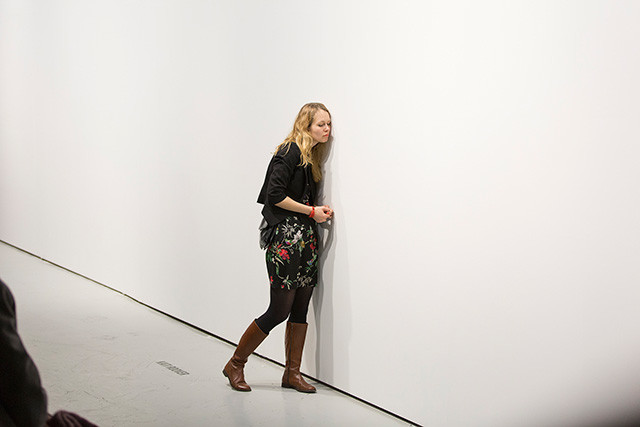Opening up Spaces
“I don’t believe curators create exhibitions
by following in anyone else’s footsteps”
Barbara Vanderlinden has originated and executed ambitious ways of analyzing and conveying curating as method on various platforms. She is less interested in rigid structures and static exhibition spaces than in more flexible projects that open up spaces and set a discourse in perpetual motion. Hans-Ulrich Obrist, with whom Barbara Vanderlinden collaborated on the project Laboratorium, describes her interest in creating a “structure of production”, wherein the curator is free to produce not merely exhibitions but events, hybrid collaborations, books, films and videos, indeed projects in any medium or combination of media her artists choose.
An important part of the recent history of art has developed by means of major institutional exhibitions conceived as a momentum, reflecting the tensions and developments within contemporary art. But I think most of the significant shows in recent years were the work of individuals rather than institutions. Arnold Bode, Harald Szeemann, Kasper König, and Pontus Hulten, for example, have asked – through the shows they have mounted – important questions about the role of the curator. Much of their work has been done outside the traditional museum, and it has stirred discussion about what an exhibition is or can be. I don’t believe curators create exhibitions by following in anyone else’s footsteps – I know I don’t. Right now I would say the curator’s task is to rethink the exhibition as a momentum. — Barbara Vanderlinden

Barbara Vanderlinden is an international curator, art critic and art historian who is currently Professor of Exhibitions Studies and Spatiality at the University of the Arts Helsinki and Director of its Exhibition Laboratory. She was Visiting Professor of the first International Curator Course of the Gwangju Biennale Foundation and co-authored The Manifesta Decade, Debates on Contemporary Art Exhibitions and Biennials in Post-Wall Europe, the first major multidisciplinary publication on current biennial and large-scale exhibition practices. Her curatorial work is associated with the decade-long experimental project Roomade and its related exhibition Laboratorium.
She has held the position of Artistic Director of the Brussels Biennial and curated platforms like the Taipei Biennial, Manifesta 2, European Biennial for Contemporary Art, and the large-scale survey exhibitions Generation Z at P.S.1 in New York. She recently completed an exhibition entitled Laboratory of Hearing, which features over forty artists who created site-specific interventions within the emptied galleries of the Exhibition Laboratory: installations, dance, performances and talks that are dedicated to sound, the most immaterial and omnipresent means of expression.

Freo Majer in conversation with Barbara Vanderlinden
Why did you decide to participate? What do you like about the general idea behind Forecast?
Forecast is quite adventurous because it aims to catalyze change and explore new terrains by making a commitment to the younger generations and helping them develop change in various fields. From a curator’s perspective, I particularly appreciate the interdisciplinary character of the project and the fact that it both instigates innovation and takes an active part in new developments. As a mentor, you give support to the personal development of a person based on your knowledge, experience and background – it is an informal transmission of knowledge and a relationship-based process that involves communication. This approach is very different to regular teaching, and that’s what I like about it – it’s a quite new model in the domain of curating, which is generally taught through classes and courses.
Forecast lets you work with projects while they are still ideas. They are often international and always very diverse, and we just step in to help to develop them, which is very enjoyable. Mentoring in itself is a very old form of teaching. It doesn’t involve spoon-feeding knowledge but accompanying people in their development and helping them catalyze change and making it understandable. But the not-so-obvious benefit is, of course, the notion of “reverse mentoring”, the fact that this younger generation of curators can help us towards new ideas. This two-way-street process is incredibly important, and that’s one of the main things I like about it.
Do you see a connection with what you’ve been doing as a professor of Exhibition Studies and Spatiality at the University of Arts in Helsinki?
Barbara Vanderlinden: One of my tasks as a professor is to build curricula with my colleagues. This implies thinking seriously about the future of art and its relation to curating and exhibition practices, because it involves developing new paths for young generations to follow. This educational role involves choosing what should be taught and how, and that is the difference from mentoring, which is far more informal and draws largely from the path the individual has chosen for him or herself. That very open process offered by Forecast is exciting. I both teach and am actively involved in curating, and this is what my mentorship will be about, spanning and drawing from both.
Curating is a field that is developing extremely fast. Fifteen years ago, it was nothing like what it is today. Now it is a significant worldwide practice, and we don’t know what the future holds. It will be very interesting to see how we can help shape the development of this relatively new profession in the field of contemporary art.
Read an interview between Hans-Ulrich Obrist and Barbara Vanderlinden about her curatorial approach.